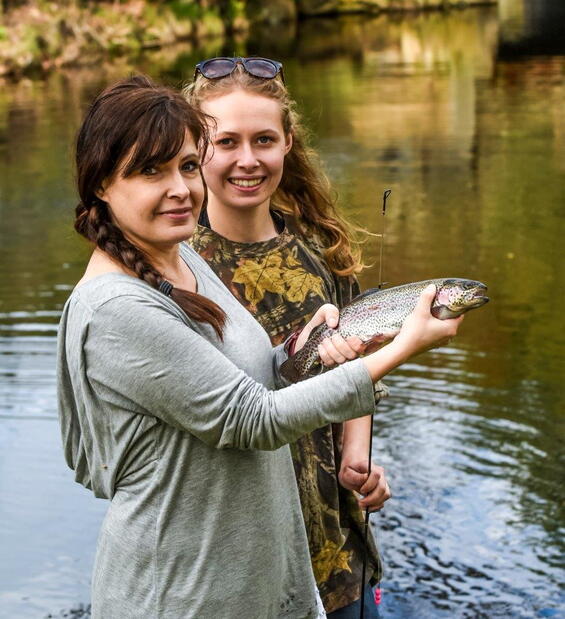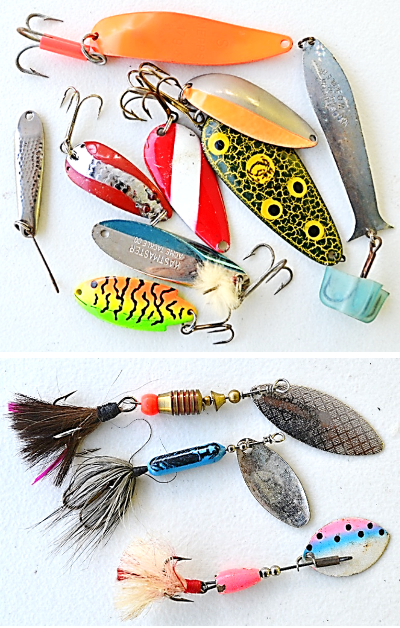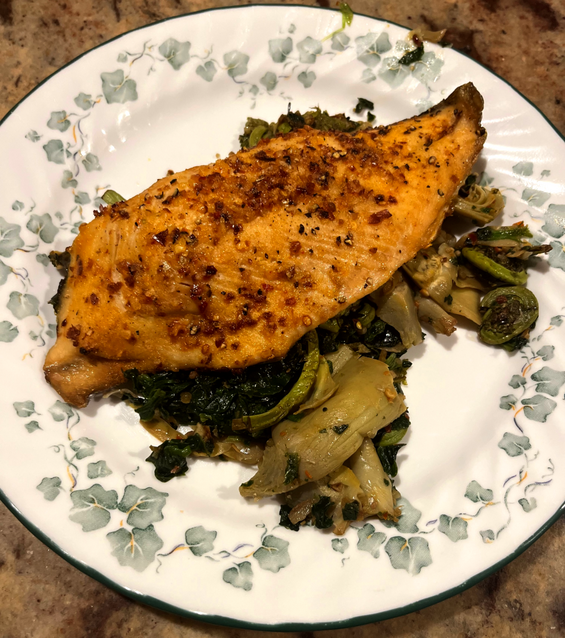Tips for catching

Try the tips below to target trout on your next fishing trip.
Live bait:
Wax worms, red worms, night crawlers, and minnows are a sure bet to get a fish's attention. Try hooking a cut piece of night crawler onto an unweighted size 6 hook and floating it into a deep, cool hole in a stream. Adding a bobber with a 12–18 inch leader can be very effective and can give you a visual cue when a fish is checking out the bait. Never dump excess live bait on the ground or into the water. Some live bait are not native species and can do harm to the environment.
TIP: Adding a wax worm onto a spinner (rooster tail or panther martin are good choices) can make artificial lures more enticing.

Lures:
- Lures can be just as effective as live bait. Unlike live bait, lures must be retrieved to produce action, typically by steadily reeling in the line with an occasional jerking motion.
- Spoons and in-line spinners (pictured), as well as dry flies and streamer flies are excellent artificial lures for targeting trout. Lures to try: Quiver Spoon (size 1/16, 1/8, and 1/4) and the rooster tail (size 1/32, 1/24, and 1/16). Also try a Little Cleo Spoon, Pixie Spoon, Blue Fox Spinner, and Mepps Spinner.
Tackle:
- Choose size 6–14 hooks and light to medium fishing line depending on the species and size fish you’re after.
TIP: Brook and rainbow trout in heavily-fished areas may be more sensitive to larger line since they can see it. In those cases, use a lower test line. - A light to medium action rod will give you enough feel, power, and reaction to land your trout.
- Massachusetts regulations state that all sinkers and jigs less than 1 oz. must be lead-free. Common non-toxic options include brass, steel, tungsten, or tin.
Location:
Go to mass.gov/trout to see where fish have been stocked near you. The map is updated daily during stocking seasons.
- Trout need cool, clean water to survive; the ideal water temperature to catch trout is between 34–67°F. During spring and fall, recently stocked trout often remain in schools in shallow waters. In the warmer summer months, fish disperse and take refuge in deeper, cooler waters. When fishing through the ice in winter, trout can be found at any depth. Ice anglers can sometimes find trout a few inches under the ice in shallow waters.
- Forested banks of streams and rivers provide shade and help keep the water cool. These naturally vegetated areas also prevent erosion, filter pollutants, and provide shelter and food for fish and other aquatic organisms.
- Trout and other fish often seek cover near submerged logs and branches.
Time of day:
Fish can be caught at any time of day. In general, fishing 2 hours after sunrise or 2 hours before sunset is more productive during any season.
Helpful links:
Tips for keeping fish
Regulations: In Massachusetts, the number of trout you can keep depends on where you are fishing and the time of year. There is no minimum size requirement except on the Housatonic River, and for lake trout on the Quabbin. Larger fish will be easier to fillet and will provide a larger meal. Learn how many fish you can keep per day and review freshwater fishing regulations.
- Bring a cooler with ice or use a stringer (improvised or store-bought).
- Pull a gill or two out with your fingers or slice through them with a knife to bleed the fish while it sits in the cooler or on the stringer. Bleeding the fish before filleting will provide a cleaner finished product without any flavor of blood in the meat.
- Be patient; filleting takes practice. Maintaining a sharp knife is essential for clean cuts.
Preparation and cooking tips
Fish are nutritious and provide a lean source of protein and omega-3 fatty acids. Learning how to prepare and cook a fish you caught yourself can be extremely rewarding.
Stocked trout are raised in hatcheries under highly controlled conditions and are safe to eat. The Department of Public Health issues consumption advisories for non-stocked fish caught in some waterbodies in Massachusetts. Familiarize yourself with the latest fish consumption advisories before eating freshwater fish.
Cleaning
To clean or “gut” your trout, you’ll need a sharp fillet knife, cutting board, and someplace to dispose of the inner organs.
- Hold the fish in the palm of your non-knife hand with the belly facing up.
- Slide the tip of your knife into the vent and gently work the blade (not too deep) toward the throat. Follow the center of the belly until you come out near the gills.
- Disconnect the throat and gills just behind the head and scoop out the inner organs in one motion. The only organ that will remain is the kidney, which is a dark line of material right against the spine. Use your thumb to scoop the kidney out before cooking a fish whole.
- Rinse with water and store on ice until you’re ready to prepare.
How to fillet
Most fillet methods start with the knife on the outside of the fish and work inward (watch a video of this method).
There are alternative fillet methods that you can try. To get a larger fillet from your trout, work the knife from the inside out to carefully separate the bones from the meat. Watch the video below to see how it's done.
Video: How to filet trout
Skip this video How to filet trout.Grilling or baking fish whole
Because trout are delicate fish, people often cook them whole. Some people opt to remove the scales before cooking. To remove the scales, hold the knife perpendicular to the fish and scrape the surface from tail to head.
- Wrap the gutted, cleaned trout in aluminum foil to help keep moisture in during cooking.
- Season both the inside cavity and the outer skin with salt and pepper.
- Other seasoning options include: paprika, citrus fruit zest and juice, butter, olive oil.
- You can stuff the cavity with vegetables like garlic, onions, spinach or even asparagus–they will steam as the fish cooks and add additional flavor.
- Grill or bake at about 350°F.
- Cook time depends on the size of the fish.
- The fish is done when the meat easily flakes off the bone. At this point, you can often remove the entire spine and rib bones with one gentle pull.
Grilling or baking a fillet
- Cook with the skin-side down on the grill or in the oven. Laying the fillet on a piece of foil will keep the cooked fillet from falling between the grill grates.
- Season with salt and pepper, along with any other preferred spices. (Other flavor options: squeeze on fresh lemon or lime juice, or glaze with honey or syrup for a caramelized, crisp layer.)
- Fillets can cook quickly; be careful not to overcook. Remove from heat when the meat easily flakes with a fork.
Frying
Frying small whole gutted trout or larger trout fillets is another simple way to enjoy trout.
- Season the skin and meat of the fish.
- Lightly coat a pan with cooking oil. Fry the fish skin-side down until the skin becomes crispy. Adding butter during the cooking process will help the skin crisp up.
- The fish is done when it flakes away from the skin and bones.
- The skin and tail can be eaten. When fried, they become crispy like a chip.
Trout recipes
Crunchy red pepper grilled trout
Ingredients:

- 2 tbsp. olive oil
- 1 tsp. cracked black pepper (larger the chunks the better)
- 1 tsp. coarse salt
- 2 tsp. red pepper flakes
- 1 tsp. dehydrated minced garlic
- 1 tsp. dehydrated minced onion
Steps:
- Combine all ingredients in a small bowl, to drizzle on the trout fillet as it cooks.
- Preheat oven or grill to 350°F.
- For easy cleanup, line the grill or baking sheet with aluminum foil and spray with cooking oil to prevent the fish from sticking.
- Place the trout fillet skin-side down on the grill or baking sheet. Brush or drizzle with oil and spice mixture.
- Add more oil and spice mixture about every 2 minutes until the fillet is cooked.
Fillet is cooked when meat easily flakes with a fork. Pair this fish with your choice of vegetables and grains like quinoa, couscous, or rice.
Before hitting the water, don’t forget to get your freshwater fishing license. Have a favorite fish or game recipe to share? Connect with us on Facebook or Instagram.